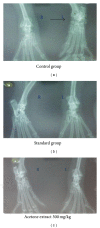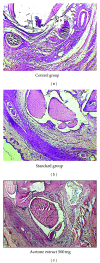Therapeutic Effects of Acetone Extract of Saraca asoca Seeds on Rats with Adjuvant-Induced Arthritis via Attenuating Inflammatory Responses
- PMID: 24729890
- PMCID: PMC3960775
- DOI: 10.1155/2014/959687
Therapeutic Effects of Acetone Extract of Saraca asoca Seeds on Rats with Adjuvant-Induced Arthritis via Attenuating Inflammatory Responses
Abstract
Saraca asoca has been traditionally used in Indian system for treatment of uterine, genital, and other reproductive disorders in women, fever, pain, and inflammation. The hypothesis of this study is that acetone extract of Saraca asoca seeds is an effective anti-inflammatory treatment for arthritis in animal experiments. The antiarthritic effect of its oral administration on Freund's adjuvant-induced arthritis has been studied in Wistar albino rats after acute and subacute toxicities. Phytochemical analysis revealed presence of high concentrations of phenolic compounds such as flavonoids and tannins, while no mortality or morbidity was observed up to 1000 mg/kg dose during acute and subacute toxicity assessments. Regular treatment up to 21 days of adjuvant-induced arthritic rats with Saraca asoca acetone extract (at 300 and 500 mg/kg doses) increases RBC and Hb, decreases WBC, ESR, and prostaglandin levels in blood, and restores body weight when compared with control (normal saline) and standard (Indomethacin) groups. Significant (P < 0.05) inhibitory effect was observed especially at higher dose on paw edema, ankle joint inflammation, and hydroxyproline and glucosamine concentrations in urine. Normal radiological images of joint and histopathological analysis of joint, liver, stomach, and kidney also confirmed its significant nontoxic, antiarthritic, and anti-inflammatory effect.
Figures







Similar articles
-
Therapeutic effect of Saraca asoca (Roxb.) Wilde on lysosomal enzymes and collagen metabolism in adjuvant induced arthritis.Inflammopharmacology. 2011 Dec;19(6):317-25. doi: 10.1007/s10787-011-0091-7. Epub 2011 Sep 23. Inflammopharmacology. 2011. PMID: 21947518
-
Pharmacognostical, phytochemical and pharmacological evaluation for the antipyretic effect of the seeds of Saraca asoca Roxb.Asian Pac J Trop Biomed. 2012 Oct;2(10):782-6. doi: 10.1016/S2221-1691(12)60229-9. Asian Pac J Trop Biomed. 2012. PMID: 23569847 Free PMC article.
-
Evaluation of Antiarthritic Activity of Butanol Fraction of Punica granatum Linn. Rind Extract Against Freund's Complete Adjuvant-Induced Arthritis in Rats.J Environ Pathol Toxicol Oncol. 2018;37(1):53-62. doi: 10.1615/JEnvironPatholToxicolOncol.2018025137. J Environ Pathol Toxicol Oncol. 2018. PMID: 29773000
-
Investigating potent cardioprotective compounds as ACE inhibitors in Saraca asoca.Toxicol Rep. 2024 Sep 10;13:101731. doi: 10.1016/j.toxrep.2024.101731. eCollection 2024 Dec. Toxicol Rep. 2024. PMID: 39309635 Free PMC article. Review.
-
Final report on the safety assessment of capsicum annuum extract, capsicum annuum fruit extract, capsicum annuum resin, capsicum annuum fruit powder, capsicum frutescens fruit, capsicum frutescens fruit extract, capsicum frutescens resin, and capsaicin.Int J Toxicol. 2007;26 Suppl 1:3-106. doi: 10.1080/10915810601163939. Int J Toxicol. 2007. PMID: 17365137 Review.
Cited by
-
Marham-Mafasel decrease joint inflammation and IL-1β gene expression in rheumatoid arthritis animal model.Vet Med Sci. 2021 Jul;7(4):1417-1425. doi: 10.1002/vms3.430. Epub 2021 May 3. Vet Med Sci. 2021. PMID: 33939304 Free PMC article.
-
Phytochemical-Based Study of Ethanolic Extract of Saraca asoca in Letrozole-Induced Polycystic Ovarian Syndrome in Female Adult Rats.ACS Omega. 2023 Nov 1;8(45):42586-42597. doi: 10.1021/acsomega.3c05274. eCollection 2023 Nov 14. ACS Omega. 2023. PMID: 38024692 Free PMC article.
-
Protective Effect of Gentianine, a compound from Du Huo Ji Sheng Tang, against Freund's Complete Adjuvant-Induced Arthritis in Rats.Inflammation. 2017 Aug;40(4):1401-1408. doi: 10.1007/s10753-017-0583-8. Inflammation. 2017. PMID: 28501981
-
Effect of umbelliferone on adjuvant-induced arthritis in rats by MAPK/NF-κB pathway.Drug Des Devel Ther. 2019 Apr 11;13:1163-1170. doi: 10.2147/DDDT.S190155. eCollection 2019. Drug Des Devel Ther. 2019. PMID: 31043769 Free PMC article.
-
Cat's whiskers (Orthosiphon stamineus) tea modulates arthritis pathogenesis via the angiogenesis and inflammatory cascade.BMC Complement Altern Med. 2016 Nov 24;16(1):480. doi: 10.1186/s12906-016-1467-4. BMC Complement Altern Med. 2016. PMID: 27881135 Free PMC article.
References
-
- Sannigrahi S, Mazumder UK, Pal D, Mishra SL, Maity S. Flavonoids of Enhydra fluctuans exhibits analgesic and anti-inflammatory activity in different animal models. Pakistan Journal of Pharmaceutical Sciences. 2011;24(3):369–375. - PubMed
-
- Sharma PV. Dravyaguna Vijnana. Varanasi, India: Chaukhamba Bharati Academy; 1995.
-
- Sharma PC, Yelne MB, Dennis TJ. Database on Medicinal Plants Used in Ayurveda. New Delhi, India: Central Council for Research in Ayurveda and Siddha, Department of ISM&H, Ministry of Health and Family Welfare; 2005.
-
- Pradhan P, Joseph L, Gupta V, et al. Saraca asoca (Ashoka): a review. Journal of Chemical and Pharmaceutical Research. 2009;1(1):62–71.
-
- Chaterjee A, Pakrashi SC. The Treatise on Indian Medicinal Plants. New Delhi, India: National Institute of Science Communication and Information Resources, CSIR; 2006.
LinkOut - more resources
Full Text Sources
Other Literature Sources
Miscellaneous

